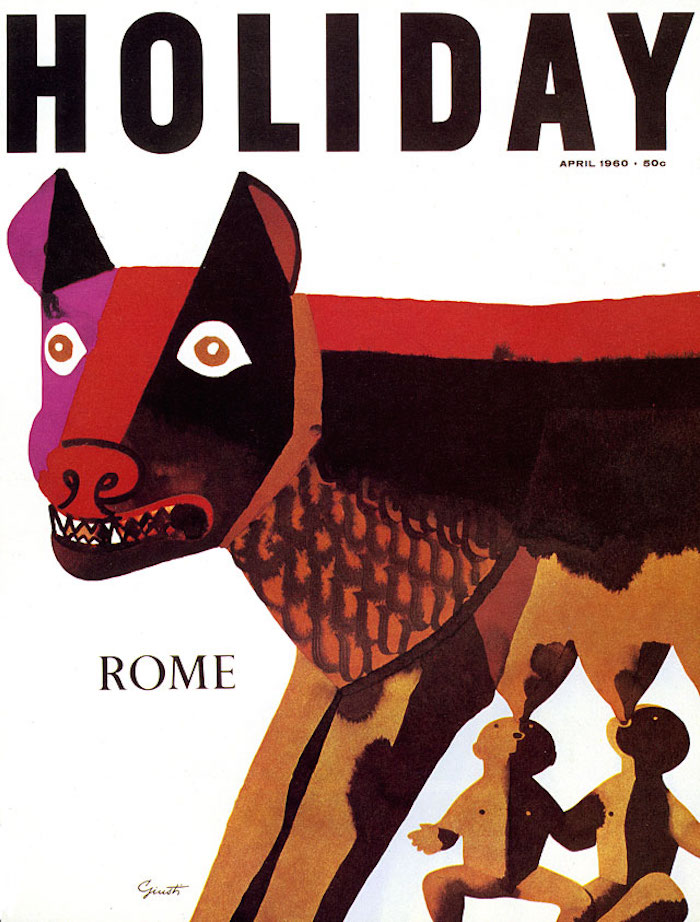As a kid, Holiday was the magazine I loved most. It came into my house along with Time, Life, National Geographic, and Boys Life, but Holiday’s beautiful photos, illustrations, and expansive size captured my interest. So did a name on its masthead under the words “Art Director”: Frank Zachary. I knew nothing about this romantic sounding title, other than thinking it had something to do with discovering and publishing all the great artwork in the magazine. And, if my assumption were correct, then that’s exactly what I would like to do after I graduated high school, if not before. That name on the masthead became my model.

Rome issue of Holiday magazine | art directed by Frank Zachary
Frank Zachary, born in 1914, died this past Friday in his East Hampton home at 101 years old. He was one of the last of a generation of inveterate magazine impresarios, and his love for the medium was palpable.
I had the extraordinarily good fortune to meet Frank in the early 1970s, over a decade after I had seen his name and long after he had left Holiday to become editor-in-chief of Town & Country. Others with whom he was close will doubtless offer professional and person tributes over the next few weeks—at least I hope so—mine is just a small piece of the enduring portrait of a monumental man who played such a role in my life that Veronique Vienne and I dedicated our book, The Education of an Art Director, to “Frank Zachary, art director, editor, patron of artists, designers, photographers, and art directors.”
That was a heartfelt dedication but an insufficient epitaph. Truth is, there were very few real gentlemen and women in magazine publishing and Frank was undeniably rare. I have written before that he was the Catalyst-in-Chief referring to the fact that neither as editor nor art director was his ego—and the power demanded from it—greater than the sum of his magazines’ parts. As editor of the great, short-lived Portfolio, he basked in designer Alexey Brodovitch’s splendid work. At Holiday and Town & Country he wanted others to accept their share of glory. His goal was to stir up the pot, find the new talents, and give them room to bloom and flower (excuse the mixed metaphors).
I first met him when a group of editorial illustrators and editors endeavored to make a visual satire magazine, somewhat like the 1896 German Simplicissimus. In addition to young, contemporary graphic satirists and commentators, the idea was to use some of the world’s best: Tomi Ungerer, Ronald Searle, Andre Francois, Roland Topor, Edward Gorey, and others who were, in fact, part of Frank’s stable of wonders.
A meeting was called at the home of John Locke, the fatherly agent for many of the European artists. In attendance were a few editor/writers, artists, and Frank, who was still actively running Town & Country (which was as far from satiric as one could get). But Frank always retained his equilibrium. His Hearst-published magazine may have been a showcase for debutants and squires, but he also longed to be part of something with bite—and offered ideas that were arguably more radical than some of the publishing neophytes in Locke’s comfortable Upper East Side living room.
Despite the enthusiastic critical mass of participants, the nameless magazine never materialized, but I had met my “model,” and we continued to meet a few times a year to discuss magazines in general. Invariably, every few months Frank would call to arrange a lunch. He called ME! And what a wellspring of insight he was into the era of postwar American design that was so significantly documented in the three extant issues of Portfolio. Frank’s varied life and history coincided with my interests: he worked for 1939 The New York World’s Fair, published a line of photography books, commissioned Paul Rand to do some covers, was a good friend of E. McKnight Kauffer at a critical time in his life, and more.
After he reached ninety, Frank would call on the phone to ask how I was. It was me who should have been calling him. But he was a true gentleman to the end. Truly interested in others with a mind that was catalytic. You know, even though his 101 years are over, he continues to be an inspiration with no end in sight.

Inaugural issue of Portfolio with Alexey Brodovitch-designed cover

